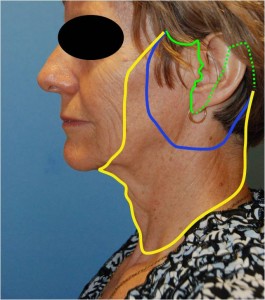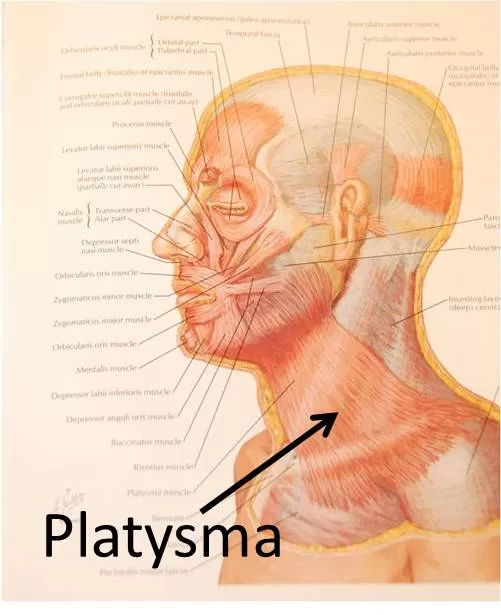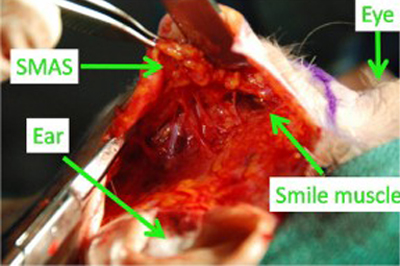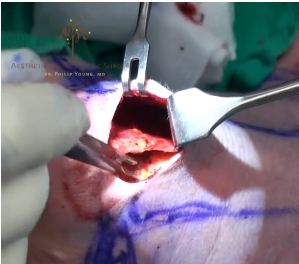Award winning, Double board certified Dr. Philip Young has performed more than 1,300 face, neck, and eyelifts, and performs 400-800 other cosmetic and reconstructive procedures each year. Did you know that Dr. Young scored the number one score in the whole entire nation when he took the written exam from the American Board of Facial Plastic and Reconstructive Surgery. This was an achievement but even more significant than that, what makes us special is Dr. Young’s groundbreaking Theory on Facial Beauty called the Circles of Prominence. Find out more here: Top Ten Reasons to Choose Dr. Philip Young.
To help you better understand the terms you can visit our Face Lift Explanation and Options Page as you read the content on this page. You can also click here to see more Facelift Before and Afters.
S lift | S Face Lift: The Term S Lift refers to the shape of the incision. As you can see in the picture below, the green arrow as it continues behind the ear can look like a reverse “S”. The S lift refers to a minimal incision face lift. The limits include the length of the incision and also the amount of dissection that the doctor does. For a mini face lift that is termed an S lift, you may lift up the skin to the blue line. What that means is that you will be receiving a procedure that is a lot less invasive and the recovery is faster based on the limits of the incision and the dissection. But, importantly you should also realize that the results are going to be less as well. Hence an S lift is really just a mini lift describing the shape of the incision. Different doctors do this differently even when they call this an S lift. As you look out in the media and all the face lifts that are marketed out there, all of these minimally invasive face lifts are just a variation of what I just described.

An important point, all facelifts nowadays entail pulling up the facial muscles for a more deeper pull. The SMAS, or superficial muscular aponeurosis system is the layer that all facelifts pull on to give the more modern face lift the pull. In the past, facelifts entailed pulling more on the skin which lead to more pulled looking results. As you can see in the picture below, the SMAS that face lift doctors are pulling are is made up of all the facial muscles but in particular it is the platysma that makes up the SMAS in the lateral part of the face where the facelifts are doing most of the pulling.

What is a mini face lift? The mini facelift is just like a S lift and many of the face lifts being marketed are some variation of what I just described. So the mini face lift is just a face lift that limits the amount of incision that you do and the amount of dissection that you carry out in front of the ear. A Traditional Face Lift, entails longer incisions (the full length of the green line in the picture above) and much more dissection past the blue line in the picture above. Many times, a traditional face lift also entails lifting up the SMAS or going into a deeper plane for more pull. Going under the SMAS muscle is a way to break up some of the adhesions that are holding the face down. This lifting of the SMAS allows the face lift surgeon to more easily lift the SMAS and take it upwards with sutures. With Traditional face lifts, the dissection can go well beyond the blue line and into the area delineated by the yellow line. You can get more results with a traditional face lift, however the risks go up when this is done and this should be something that you ask your doctor.
The SMAS Lift: As I explained earlier, the SMAS is the superficial Muscular Aponeurotic System. This is just a complicated term for the distinct layer that is made of the facial muscles and the connective tissue covering that encapsulates the facial muscles. This is a lift that entails pulling up on the SMAS. So really this could be a mini face lift or a traditional face lift with the variations being in the length of the incision, the extent of the dissection, and whether the SMAS is pulled up by sutures or elevated deep to it surgically and then lifted. Below is a surgical picture of the SMAS being elevated deep to it. You can see the SMAS in the picture as it is being elevated by the instrument. The facial nerves are just under this layer.Most mini face lifts do not elevated deep to the SMAS and instead lift the SMAS with sutures by catching the SMAS with the suture inferiorly and tacking it superiorly and lifting as you tie the sutures tighter.

The Quick Lift: is just like the S lift or Mini Face Lift. The major difference that I see is that the Quick Lift uses barbed sutures to keep the lift up that eventually dissolve. I have seen this done by other surgeons and it appears to be just like other mini face lifts. In terms of the barbed sutures, I think that the real important issue is how long the sutures and barbs last. You really need the effect to be lasting at least 6 months to a year for your tissues to really adjust to the new position. If the sutures dissolve earlier this could make the results not last as long. In short, the Quick Lift is a variation of the mini face lift.
The Lunch Time Face Lift: This face lift is termed lunch time because you are supposed to have this lift during lunch time and be able to carry on your usual activities after the lunch period and the face lift that you receive during that time. One thing to realize is the less you put into something the less you are going to get. I think that the lunch time face lift is a little misleading. In my experience and opinion, you are not going to feel like carrying on your normal activities after a lunch time face lift. The lunch time face lift is yet again another mini facelift with the same variables of length of incision, extent of dissection and elevation of the skin, and how the SMAS is treated (either lifting it or elevating it deep then lifting it).
The Deep Plane Face Lift: The deep plane is really the space or plane deep to the SMAS. If you look at the picture above of an actual surgery it is the plane that you are seeing under the SMAS. Facelifts that entail going deep to the SMAS are refered to as Deep Plane Face Lifts. These face lifts are usually associated with traditional face lifts.
Neck Lift: There is a lot of confusion regarding the neck lift and face lift and what are the differences between the two. The facelift entails pulling up the SMAS as discussed above. The incision of the face lift is located around the ear as shown in green with the very first picture. All facelifts improve the neck to varying degrees depending on how its done and how extensive the face lift is carried out. However, if you really want improvement in the Neck, you need to do a Neck Lift that addresses this area specifically. The way this is done is through an incision under the chin. The elevation of the skin is carried more towards the yellow line in the very first picture. The once this is done we remove as much fat as possible in the neck and deep to the neck muscles. As you can see in the picture below, the neck muscle is seen just superior to the instrument. The instrument is actually in a space deep to the platysma muscle where we just got done clearing the fat and tissue under the platysma muscle. Notice that the fat has been removed above and below the muscle shown. This will help us really sculpt the neck. The next thing we do is we start suturing the muscle and tightening it to contour the neck and tighten the neck. You can see a video of this on our Neck Lift Page. You have to scroll to the bottom to see where all the videos are located.

The Vampire Lift: This is a lift that people have asked me about. This entails treating your blood by concentrating certain elements in your blood that is eventually injected into your face. The goal is that the stem cells are used to rejuvenate the face. Some of the questions that I would ask are: what kind of tissue gives your face volume and shape? Is it blood that makes your face the way it looks? To me your face is made up of facial muscles, fat, connective tissues, blood vessels, nerves, etc. Blood is a very small component. Another question to ask is: What are the before and afters looking like? Do they show true results that I would be happy with? These are important questions to ask.
The Incision Less Face Lift Alternative: With all of this surgery, you might be wondering if there are alternatives. I think that there are a lot better alternatives out there. Dr. Young has developed the YoungVitalizer to address this issue. The YoungVitalizer is an incision less face lift alternative that shapes your face and makes you look younger in a natural way. The YoungVitalizer requires no facial incisions, and there is minimal discomfort after the procedure. You also are not put under general anesthesia. The complication rates for the YoungVitalizer are much lower compared to the face lift or mini face lifts. You can read more about the YoungVitalizer on our YoungVitalizer Page on this website or on our specific YoungVitalizer website page: http://www.youngvitalizer.com
